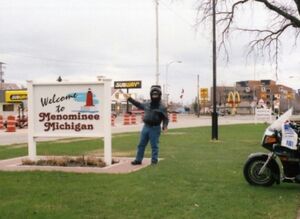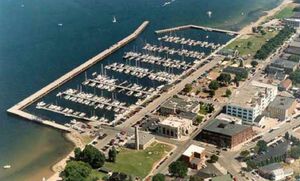Menominee is a city in the Upper Peninsula of the U.S. state of Michigan. The population was 8,599 at the 2010 census. It is the county seat of Menominee County.[6] Menominee is the fourth-largest city in the Upper Peninsula, behind Marquette, Sault Ste. Marie, and Escanaba. Menominee Township is located to the north of the city, but is politically autonomous.

Sign welcoming all newcomers.
Menominee is part of the Marinette, WI–MI Micropolitan Statistical Area.
History[]
Menominee gets its name from a regional Native American tribe known as The Menominee, which roughly translates into "Wild Rice." The area was originally the home of the Menominee Indian Tribe. They now have a reservation along the Wolf River in North Central Wisconsin.
Menominee gained prominence as a lumber town. In its heyday Menominee produced more lumber than any other city in America. During this time and shortly after, Menominee boasted an opera house, which is now being restored.[7] In the 1910s a cycle car, the "Dudly Bug", was manufactured in Menominee. In the waning years of lumber production, local business interests, interested in diversifying Menominee's manufacturing base, attracted to Menominee inventor Marshall Burns Lloyd and his Minneapolis company Lloyd Manufacturing — a manufacturer of wicker baby buggies. In 1917 Lloyd invented an automated process for weaving a man-made wicker and the Lloyd Loom was born — a process still in use today.[8] Today, Menominee relies on manufacturing (paper products, wicker lawn furniture, auto supplies, tourism, etc.) for its economic well-being.
In 1940, during the "Vote for Gracie" publicity stunt in which Gracie Allen ran for President, she was nominated Mayor of Menominee, but disqualified because she was not a resident of the city.[9]
The Menominee Maroons won the state championship in its division for basketball in 1967 and football in 1998, 2006 and 2007.In the 2006 season the Maroons finished unbeaten and only allowed 38 points scored against them but their offense scored 513 point in that entire season . They beat the former Wisconsin and Minnesota Division One state champions. Menominee shares a historic football rivalry with neighbor Marinette, Wisconsin. The two were noted as hosting the oldest interstate high school rivalry in the country and it is now recognized as the third longest rivalry.[10]
Menominee shares a hospital, community foundation, newspaper and chamber of commerce with Marinette. Numerous city groups work together to benefit the entire, two-city, two-county community.
Menominee's waterfront is the setting for events all summer long, including a city-sponsored festival. The Marinette Menominee Area Chamber of Commerce coordinates a concert series held on Thursdays from late June to mid-August. The Cabela Master Walleye Circuit brought hundreds of fishermen and women to the area for tournaments in 2005, 2008 and 2009.
Geography[]
According to the United States Census Bureau, the city has a total area of 5.48 square miles (14.19 km2), of which 5.15 square miles (13.34 km2) is land and 0.33 square miles (0.85 km2) is water.[1] It is the southernmost city and location in Michigan's Upper Peninsula.

Aerial view of the Menominee Marina.
Menominee has a cairn marking the halfway point between the North Pole and theEquator. This is slightly north of the 45th parallel north, due to the flattening of the earth at the poles. This is one of six Michigan sites and 29 places in the U.S.A. where such signs are known to exist.[11]
Demographics[]
2010 census[]
As of the census[2] of 2010, there were 8,599 people, 3,987 households, and 2,311 families residing in the city. The population densitywas 1,669.7 inhabitants per square mile (644.7 /km2). There were 4,456 housing units at an average density of 865.2 per square mile (334.1 /km2). The racial makeup of the city was 96.7% White, 0.4% African American, 0.9% Native American, 0.5% Asian, 0.2% fromother races, and 1.2% from two or more races. Hispanic or Latino of any race were 1.4% of the population.
There were 3,987 households of which 26.3% had children under the age of 18 living with them, 40.0% were married couples living together, 12.6% had a female householder with no husband present, 5.4% had a male householder with no wife present, and 42.0% were non-families. 37.1% of all households were made up of individuals and 14.5% had someone living alone who was 65 years of age or older. The average household size was 2.13 and the average family size was 2.74.
The median age in the city was 44 years. 21.8% of residents were under the age of 18; 7% were between the ages of 18 and 24; 22.7% were from 25 to 44; 30.3% were from 45 to 64; and 18.3% were 65 years of age or older. The gender makeup of the city was 48.7% male and 51.3% female.
2000 census[]
As of the census[4] of 2000, there were 9,131 people, 4,063 households, and 2,441 families residing in the city. The population densitywas 1,763.2 per square mile (680.6/km²). There were 4,393 housing units at an average density of 848.3 per square mile (327.4/km²). The racial makeup of the city was 97.35%White, 0.14% African American, 0.82% Native American, 0.32% Asian, 0.27% from other races, and 1.10% from two or more races.Hispanic or Latino of any race were 1.12% of the population. 31.6% were of German, 9.3%French, 8.7% Swedish, 8.7% Polish, 7.2% Irishand 6.7% French Canadian ancestry according to Census 2000.
There were 4,063 households out of which 27.9% had children under the age of 18 living with them, 43.6% were married couples living together, 12.4% had a female householder with no husband present, and 39.9% were non-families. 35.3% of all households were made up of individuals and 15.0% had someone living alone who was 65 years of age or older. The average household size was 2.22 and the average family size was 2.86.
In the city the population was spread out with 23.9% under the age of 18, 9.4% from 18 to 24, 25.8% from 25 to 44, 22.8% from 45 to 64, and 18.2% who were 65 years of age or older. The median age was 39 years. For every 100 females there were 92.8 males. For every 100 females age 18 and over, there were 90.4 males.
The median income for a household in the city was $30,523, and the median income for a family was $38,867. Males had a median income of $32,850 versus $22,145 for females. The per capita income for the city was $17,500. About 9.9% of families and 13.3% of the population were below thepoverty line, including 18.2% of those under age 18 and 11.9% of those age 65 or over.
Historic Downtown and Marina[]
Much of Menominee's L-shaped downtown runs along the shores of the bay of Green Bay and includes the Great Lakes Memorial Marina and park. Many of the downtown buildings, built at the end of the 19th century or the beginning of the 20th, have been restored. They now provide space for several upscale restaurants, gift shops, beauty salons and day spas, antiques shops, galleries and a variety of essential services. The Menominee Bandshell is a focal point for concerts, an art show, a car show and a four-day community festival.
Jobs[]
The greater Menominee area is home to a variety of industries, including shipbuilding, auto parts, chemicals, helicopter design and construction, airplane components, health care, and paper making. In good financial times, some local companies have reported a shortage of skilled workers.
The types of jobs available locally include assemblers, assembly coordinators, building and grounds technicians, custodians, cutting machine operators, electricians, fabrication operators, fixture technicians, journeyman toolmakers, machinists, maintenance mechanics, material handlers, metal fabricators, forklift drivers, paint coordinators, powder coating specialists, research-and-development technicians, quality control technicians, sewing and weaving machine operators, shipping/loading/receiving attendants, spinning and rewind machine operators, cutters, stamping operators, welders, and welding coordinators.
Notable people[]
- James Bonk, longtime chemistry professor,Duke University
- Mitchell Leisen, Hollywood director, art director and costumer designer
- Dave Mason, NFL player
- Bill Rademacher, NFL player, Super Bowl III Champion
- Alvin Nielsen, molecular spectroscopist (and brother of Harald Herborg Nielsen)
- The McDonald Cousins
- Harald Herborg Nielsen, physicist (and brother of Alvin H. Nielsen)
- Richard Math, Wisconsin State Assemblyman
- John McLean, Olympic silver medal winner
- William Nolde, last American soldier killed in Vietnam
- Fred Stephenson Norcross, University of Michigan football captain, coach Oregon State University
- Doris Packer, actress (played Mrs. Rayburn,Theodore Cleaver's principal in the television series Leave It to Beaver)
- Samuel Stephenson, member of United States House of Representatives from Michigan
- Bart Stupak, member of US House of Representatives from Michigan
- Jacob Pedersen, NFL player.
Transportation[]
- US 41 connects with Escanaba and Marquette to the north and Marinette, Wisconsin and Green Bay, Wisconsin to the south.
- M‑35 runs northeast to provide a more direct route to Escanaba along the shore of Lake Michigan's Green Bay.
- WIS 64 starts just across the state line in Marinette and travels westerly.
- WIS 180 starts just across the state line in Marinette and travels northerly then westerly.
- Indian Trails Bus Lines operates daily intercity bus service between Hancock and Milwaukee, WI with a stop in Menominee.[12]
Climate[]
This climatic region is typified by large seasonal temperature differences, with warm to hot (and often humid) summers and cold (sometimes severely cold) winters. According to the Köppen Climate Classification system, Menominee has a humid continental climate, abbreviated "Dfb" on climate maps.[13]